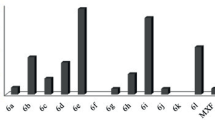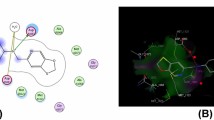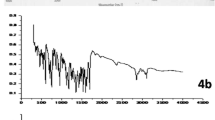Abstract
Quinolinone-chalcones are hybrid compounds consisting of chalcone and quinolone moieties with biological activity related to their hybrid structure. This work seeks to describe the structural and theoretical parameters related to the physicochemical properties and biological activity of a new quinolinone-chalcone. The synthesis, structural characterization by X-ray diffraction, molecular topology by Hirshfeld surfaces and QTAIM, molecular electronic calculations, and pharmacophore analysis were described. The weak interactions C–H…O, C–H…π, and C–H…Br were responsible for crystal growth and stabilized the crystalline state. The DFT analysis shows that the sulfonamide group region is susceptible to observed interactions, and the frontier molecular orbitals indicate high kinetic stability. Also, pharmacophore analysis revealed potential antibacterial and herbicidal activity; by docking within the active site of TtgR, a transcription regulator for the efflux pump TtgABC from the highly resistant Pseudomonas putida (P. putida) strain DOT-TIE, we showed that the activation of TtgR relies upon the binding of aromatic-harboring compounds, which plays a crucial role in bacterial evasion. In this context, a new quinolinone-chalcone has a higher binding affinity than tetracycline, which suggests it might be a better effector for TtgR.













Similar content being viewed by others
Data availability
The datasets generated during and analyzed during the current study are available in the Cambridge Crystallographic Data Centre (CCDC), under the code 1,934,999 (https://www.ccdc.cam.ac.uk/structures/?).
References
Botta M (2018) Neglected diseases : extensive space for modern drug discovery, 1st edn. Academic Press
Jain S, Chandra V, Kumar Jain P et al (2016) Comprehensive review on current developments of quinoline-based anticancer agents. Arab J Chem. https://doi.org/10.1016/j.arabjc.2016.10.009
Li W, Xu F, Shuai W et al (2019) Discovery of novel quinoline–chalcone derivatives as potent antitumor agents with microtubule polymerization inhibitory activity. J Med Chem 62:993–1013. https://doi.org/10.1021/acs.jmedchem.8b01755
Roussaki M, Hall B, Lima SC et al (2013) Synthesis and anti-parasitic activity of a novel quinolinone–chalcone series. Bioorg Med Chem Lett 23:6436–6441. https://doi.org/10.1016/j.bmcl.2013.09.047
Dave SS, Ghatolea AM, Rahatgaonkar AM et al (2009) Experimental and computational evaluation of new quinolinyl chalcones as potent antiplasmodial agents. Indian J Chem 48B:1780–1793
Charris JE, Monasterios MC, Acosta ME et al (2019) Antimalarial, antiproliferative, and apoptotic activity of quinoline-chalcone and quinoline-pyrazoline hybrids. A dual action. Med Chem Res 28:2050–2066. https://doi.org/10.1007/s00044-019-02435-0
Kumar H, Wadi I, Devaraji V et al (2019) A novel quinoline-appended chalcone derivative as potential Plasmodium falciparum gametocytocide. J Vector Borne Dis 56:189. https://doi.org/10.4103/0972-9062.289398
Rao NS, Shaik AB, Routhu SR et al (2017) New quinoline linked chalcone and pyrazoline conjugates: molecular properties prediction, antimicrobial and antitubercular activities. ChemistrySelect 2:2989–2996. https://doi.org/10.1002/slct.201602022
Nguyen GTT, Erlenkamp G, Jäck O et al (2016) Chalcone-based Selective Inhibitors of a C4 Plant Key Enzyme as Novel Potential Herbicides. Sci Rep 6:27333. https://doi.org/10.1038/srep27333
Vaz WF, Neves BJ, Custodio JMF et al (2021) In silico-driven identification and structural analysis of nitrodihydroquinolinone pesticide candidates with antifungal activity. J Mol Struct 1226:129326. https://doi.org/10.1016/j.molstruc.2020.129326
Takahashi M, Takara K, Toyozato T, Wada K (2012) A novel bioactive chalcone of Morus australis inhibits tyrosinase activity and melanin biosynthesis in B16 melanoma cells. J Oleo Sci 61:585–592. https://doi.org/10.5650/jos.61.585
Panzella L, Napolitano A (2019) Natural and bioinspired phenolic compounds as tyrosinase inhibitors for the treatment of skin hyperpigmentation: recent advances. Cosmetics 6:57. https://doi.org/10.3390/cosmetics6040057
Sashidhara KV, Avula SR, Mishra V et al (2015) Identification of quinoline-chalcone hybrids as potential antiulcer agents. Eur J Med Chem 89:638–653. https://doi.org/10.1016/j.ejmech.2014.10.068
Huang Z-H, Yin L-Q, Guan L-P et al (2020) Screening of chalcone analogs with anti-depressant, anti-inflammatory, analgesic, and COX-2-inhibiting effects. Bioorg Med Chem Lett 30:127173. https://doi.org/10.1016/j.bmcl.2020.127173
Abonia R, Insuasty D, Castillo J et al (2012) Synthesis of novel quinoline-2-one based chalcones of potential anti-tumor activity. Eur J Med Chem 57:29–40. https://doi.org/10.1016/j.ejmech.2012.08.039
Prasath R, Bhavana P, Ng SW, Tiekink ERT (2013) The facile and efficient ultrasound-assisted synthesis of new quinoline-appended ferrocenyl chalcones and their properties. J Organomet Chem 726:62–70. https://doi.org/10.1016/j.jorganchem.2012.12.022
Orhan Puskullu M, Tekiner B, Suzen S (2013) Recent studies of antioxidant quinoline derivatives. Mini Rev Med Chem 13:365–372. https://doi.org/10.2174/138955713804999793
Go M, Wu X, Liu X (2005) Chalcones: an update on cytotoxic and chemoprotective properties. Curr Med Chem 12:483–499. https://doi.org/10.2174/0929867053363153
Faria ECM, Duarte VS, de Paula RLG et al (2021) Comparative study of chalcones and their potential as additives for biofuels. Energy Fuels 35:552–560. https://doi.org/10.1021/acs.energyfuels.0c03448
Piva E, De Oliveira M, Rockembach CT et al (2013) Aplicação de Chalconas como Reagente Antioxidante em Biodiesel
Kumar N (2017) Oxidative stability of biodiesel: causes, effects and prevention. Fuel 190:328–350. https://doi.org/10.1016/j.fuel.2016.11.001
Knothe G, Razon LF (2016) Biodiesel fuels. https://doi.org/10.1016/j.pecs.2016.08.001
Hamlaoui I, Bencheraiet R, Bensegueni R, Bencharif M (2018) Experimental and theoretical study on DPPH radical scavenging mechanism of some chalcone quinoline derivatives. J Mol Struct 1156:385–389. https://doi.org/10.1016/j.molstruc.2017.11.118
Szczesio M, Gołka J, Korona-głowniak I (2018) Planarity of heteroaryldithiocarbazic acid derivatives showing tuberculostatic activity : structure – activity relationships research papers. 2:400–405. https://doi.org/10.1107/S205322961800284X
Zeljezic D (2016) Assessment of Potential Carcinogenicity by Quantitative Structure-Activity Relationship (QSAR). https://doi.org/10.5772/intechopen.75420
Cao H, Cheng W-X, Li C et al (2005) DFT study on the antioxidant activity of rosmarinic acid. J Mol Struct Theochem 719:177–183. https://doi.org/10.1016/j.theochem.2005.01.029
Di MD, Giammanco M, La GM et al (2005) Flavanones in Citrus fruit: Structure–antioxidant activity relationships. Food Res Int 38:1161–1166. https://doi.org/10.1016/J.FOODRES.2005.05.001
Tu B, Liu Z, Chen Z et al (2015) RSC Advances Understanding the structure – activity relationship between quercetin and naringenin : in vitro. RSC Adv 5:106171–106181. https://doi.org/10.1039/C5RA22551E
Zeslawska E, Korona-Glowniak I, Szczesio M et al (2017) Structural analysis and antimicrobial activity of 2[1H]-pyrimidinethione/selenone derivatives. J Mol Struct 1142:261–266. https://doi.org/10.1016/j.molstruc.2017.04.067
Stumpfe D, Bajorath J (2012) Exploring Activity Cliffs in Medicinal Chemistry. J Med Chem 55:2932–2942. https://doi.org/10.1021/jm201706b
Seebeck B, Wagener M, Rarey M (2011) From Activity Cliffs to Target-Specific Scoring Models and Pharmacophore Hypotheses. ChemMedChem 6:1630–1639. https://doi.org/10.1002/cmdc.201100179
Spackman MA, Jayatilaka D (2009) Hirshfeld surface analysis. CrystEngComm 11:19–32. https://doi.org/10.1039/B818330A
Burke K (2012) Perspective on density functional theory. J Chem Phys 136:1–10. https://doi.org/10.1063/1.4704546
Pereira DH, La PFA, Santiago RT et al (2016) New Perspectives on the Role of Frontier Molecular Orbitals in the Study of Chemical Reactivity: A Review. Rev Virtual Química 8:425–453. https://doi.org/10.5935/1984-6835.20160032
Sjoberg P, Politzer P (1990) Use of the Electrostatic Potential at the Molecular Surface. 3959–3961. https://doi.org/10.1021/j100373a017
d’Oliveira G, Moura A, de Moraes M et al (2018) Synthesis, Characterization and Evaluation of in vitro Antitumor Activities of Novel Chalcone-Quinolinone Hybrid Compounds. J Braz Chem Soc. https://doi.org/10.21577/0103-5053.20180108
Chikhalia KH, Patel MJ, Vashi DB (2008) Design, synthesis and evaluation of novel quinolyl chalcones as antibacterial agents
De Castro MRC, Aragão ÂQ, Da Silva CC et al (2016) Conformational variability in sulfonamide chalcone hybrids: Crystal structure and cytotoxicity. J Braz Chem Soc 27:884–898. https://doi.org/10.5935/0103-5053.20150341
Dolomanov OV, Bourhis LJ, Gildea RJ et al (2009) OLEX2: a complete structure solution, refinement and general all round good thing Olex2. J Appl Crystallogr 42:339–341. https://doi.org/10.1107/S0021889808042726
Sheldrick GM (2015) SHELXT – Integrated space-group and crystal-structure determination. Acta Crystallogr Sect A Found Adv 71:3–8. https://doi.org/10.1107/S2053273314026370
Muller P, Herbst-Irmer R, Spek AL et al (2006) Crystal Structure Refinement - A Crystallographer’s Guide to SHELXL, 1st edn. Oxford University Press, New York
Macrae CF, Edgington PR, McCabe P et al (2006) Mercury: Visualization and analysis of crystal structures. J Appl Crystallogr 39:453–457. https://doi.org/10.1107/S002188980600731X
Wolff SK, Grimwood DJ, McKinnon JJ et al (2012) CrystalExplorer17
Groom CR, Bruno IJ, Lightfoot MP, Ward SC (2016) The Cambridge structural database. Acta Crystallogr Sect B Struct Sci Cryst Eng Mater. https://doi.org/10.1107/S2052520616003954
Spackman MA, McKinnon JJ (2002) Fingerprinting intermolecular interactions in molecular crystals. CrystEngComm 4:378–392. https://doi.org/10.1039/B203191B
Zhao Y, Truhlar DG (2008) The M06 suite of density functionals for main group thermochemistry, thermochemical kinetics, noncovalent interactions, excited states, and transition elements: Two new functionals and systematic testing of four M06-class functionals and 12 other function. Theor Chem Acc 120:215–241. https://doi.org/10.1007/s00214-007-0310-x
Frisch MJ., Trucks GW, Schlegel HB et al (2009) Gaussian 09, Revision A.02; Gaussian Inc.: Wallingford CT. 201
Hohenstein EG, Chill ST, Sherrill CD (2008) Assessment of the performance of the M05#2X and M06#2X exchange correlation functionals for noncovalent interactions in biomolecules. J Chem Theory Comput 4:1996–2000. https://doi.org/10.1021/ct800308k
Wiberg KB, Box PO, Haven N (2004) Basis Set Effects on Calculated Geometries : 6–311++ G ** vs. aug-cc-pVDZ. 25:1342–1346. https://doi.org/10.1002/jcc.20058
Sousa SF, Fernandes PA, Ramos MJ (2007) General Performance of Density Functionals. J Phys Chem A 111:10439–10452. https://doi.org/10.1021/jp0734474
Grant GH, Richards WG, William G (1996) Computational chemistry. Oxford University Press
Zhang G, Musgrave CB (2007) Comparison of DFT Methods for Molecular Orbital Eigenvalue Calculations. https://doi.org/10.1021/jp061633o
Bader RFW (1990) Atoms in molecules: a quantum theory. Clarendon Press
Bader RFW (2005) The quantum mechanical basis of conceptual chemistry. Monatshefte Chem 136:819–854. https://doi.org/10.1007/s00706-005-0307-x
Lu T, Chen F (2011) Multiwfn : A Multifunctional Wavefunction. Analyzer. https://doi.org/10.1002/jcc.22885
Schneidman-Duhovny D, Dror O, Inbar Y et al (2008) Deterministic Pharmacophore Detection via Multiple Flexible Alignment of Drug-Like Molecules. J Comput Biol 15:737–754. https://doi.org/10.1089/cmb.2007.0130
Trott O, Olson AJ (2009) AutoDock Vina: Improving the speed and accuracy of docking with a new scoring function, efficient optimization, and multithreading. J Comput Chem 31:NA-NA. https://doi.org/10.1002/jcc.21334
Pettersen EF, Goddard TD, Huang CC et al (2004) UCSF Chimera - A visualization system for exploratory research and analysis. J Comput Chem 25:1605–1612. https://doi.org/10.1002/jcc.20084
Gupta D, Jain DK (2015) Chalcone derivatives as potential antifungal agents: Synthesis, and antifungal activity. J Adv Pharm Technol Res | Publ by Wolters Kluwer-Medknow J Adv Pharm Technol Res. https://doi.org/10.4103/2231-4040.161507
Marquina S, Maldonado-Santiago M, Sánchez-Carranza JN et al (2019) Design, synthesis and QSAR study of 2′-hydroxy-4′-alkoxy chalcone derivatives that exert cytotoxic activity by the mitochondrial apoptotic pathway. Bioorg Med Chem 27:43–54. https://doi.org/10.1016/j.bmc.2018.10.045
Smith NM, Soh P, Asokananthan N et al (2009) Immunomodulatory effects of functionalised chalcones on pro-inflammatory cytokine release from lung epithelial cells. New J Chem 33:1869. https://doi.org/10.1039/b909172f
Bruno IJ, Cole JC, Kessler M et al (2004) Retrieval of Crystallographically-Derived Molecular Geometry Information. J Chem Inf Comput Sci 44:2133–2144. https://doi.org/10.1021/ci049780b
Hamama WS, Ibrahim ME, Gooda AA, Zoorob HH (2017) Convenient synthesis, antimicrobial evaluation and molecular modeling of some novel quinoline derivatives. Synth Commun 47:224–231. https://doi.org/10.1080/00397911.2016.1258580
Kumar H, Chattopadhyay A, Prasath R et al (2014) Design, Synthesis, Physicochemical Studies, Solvation, and DNA Damage of Quinoline-Appended Chalcone Derivative: Comprehensive Spectroscopic Approach toward Drug Discovery. J Phys Chem B 118:7257–7266. https://doi.org/10.1021/jp5025262
d’Oliveira GDC, Custodio JMF, Moura AF et al (2019) Different reactivity to glutathione but similar tumor cell toxicity of chalcones and their quinolinone analogues. Med Chem Res 28:1448–1460. https://doi.org/10.1007/s00044-019-02384-8
Khan SA (2017) Green Synthesis, Spectrofluorometric Characterization and Antibacterial Activity of Heterocyclic Compound from Chalcone on the Basis of in Vitro and Quantum Chemistry Calculation. J Fluoresc 27:929–937. https://doi.org/10.1007/s10895-017-2028-z
Michelini LJ, Vaz WF, D’Oliveira GDC et al (2019) Analysis of two novel 1–4 quinolinone structures with bromine and nitrobenzyl ligands. J Mol Model 25:55. https://doi.org/10.1007/s00894-019-3937-3
Toche RB, Kazi MA, Patil SP et al (2010) Synthesis of Quinolone Substituted Pyrazoles, Isoxazoles and Pyridines as a Potential Blue Luminophors. J Fluoresc 20:1129–1137. https://doi.org/10.1007/s10895-010-0654-9
Rozas I, Alkorta I, Elguero J (2000) Behavior of Ylides Containing N, O, and C Atoms as Hydrogen Bond Acceptors. J Am Chem Soc 122:11154–11161. https://doi.org/10.1021/ja0017864
Popelier PLA (1998) Characterization of a Dihydrogen Bond on the Basis of the Electron Density. J Phys Chem A 102:1873–1878
Koch U, Popelier PLA (1995) Characterization of C-H-O Hydrogen Bonds on the Basis of the Charge Density. J Phys Chem 99:9747–9754. https://doi.org/10.1021/j100024a016
Silva López C, Olalla FN et al (2005) Ellipticity: A Convenient Tool To Characterize Electrocyclic Reactions. Chem Eur J 11:1734–1738. https://doi.org/10.1002/chem.200401026
Vaz WF, D’Oliveira GDC, Perez CN et al (2020) Machine learning prediction of the potential pesticide applicability of three dihydroquinoline derivatives: Syntheses, crystal structures and physical properties. J Mol Struct 1206:127732. https://doi.org/10.1016/j.molstruc.2020.127732
Díaz-Tielas C, Graña E, Reigosa MJ, Sánchez-Moreiras AM (2016) Atividades Biológicas e Novas Aplicações das Chalconas. Planta Daninha 34:607–616. https://doi.org/10.1590/S0100-83582016340300022
Powles SB, Yu Q (2010) Evolution in Action: Plants Resistant to Herbicides. Annu Rev Plant Biol 61:317–347. https://doi.org/10.1146/annurev-arplant-042809-112119
Rocha JE, de Freitas TS, da Cunha XJ et al (2021) Antibacterial and antibiotic modifying activity, ADMET study and molecular docking of synthetic chalcone (E)-1-(2-hydroxyphenyl)-3-(2,4-dimethoxy-3-methylphenyl)prop-2-en-1-one in strains of Staphylococcus aureus carrying NorA and MepA efflux pumps. Biomed Pharmacother 140:111768. https://doi.org/10.1016/j.biopha.2021.111768
Youssif BGM (2019) Synthesis and biological evaluation of novel quinoline / chalcone hybrid as potential antibacterial agents. Int J Pharm Sci Res 10:2423–2429. https://doi.org/10.13040/IJPSR.0975-8232.10(5).2423-29
Xu M, Wu P, Shen F et al (2019) Chalcone derivatives and their antibacterial activities: Current development. Bioorg Chem 91:1–17. https://doi.org/10.1016/j.bioorg.2019.103133
Fernandez-Escamilla AM, Fernandez-Ballester G, Morel B et al (2015) Molecular Binding Mechanism of TtgR Repressor to Antibiotics and Antimicrobials. PLoS One 10:e0138469. https://doi.org/10.1371/journal.pone.0138469
Terán W, Felipe A, Segura A et al (2003) Antibiotic-Dependent Induction of Pseudomonas putida DOT-T1E TtgABC Efflux Pump Is Mediated by the Drug Binding Repressor TtgR. Antimicrob Agents Chemother 47:3067–3072. https://doi.org/10.1128/AAC.47.10.3067-3072.2003
Acknowledgements
The authors would like to thank Brazilian funding agencies Conselho Nacional de Desenvolvimento Científico e Tecnológico (CNPq) and Coordenação de Aperfeiçoamento Pessoal de Nível Superior (CAPES) for financial support. QC X-ray data collection was undertaken at the University of Notre Dame. Theoretical calculations were performed in the High-Performance Computing Center of State University of Goiás. In addition, the authors thank Prof. Dr. Ademir Joao Camargo for fruitful discussion regarding the solvent effect calculations.
Funding
This work was supported by Conselho Nacional de Desenvolvimento Científico e Tecnológico (CNPq) and Coordenação de Aperfeiçoamento Pessoal de Nível Superior (CAPES).
Author information
Authors and Affiliations
Contributions
Vitor S. Duarte: conceptualization, formal analysis, writing (original draft), writing (review and editing). Renata Layse G. de Paula: conceptualization, formal analysis, writing (original draft). Jean M. F. Custodio: conceptualization, revision, writing (original draft). Giulio D. C. D’Oliveira: synthesis, methodology, validation, writing (original draft), writing (review and editing). Leonardo L. Borges: methodology, validation, formal analysis, investigation, writing (original draft), writing (review and editing). Caridad Noda Pérez: synthesis, methodology, validation, writing (original draft), writing (review and editing). Pal Perjesi: conceptualization, formal analysis, writing (original draft). Allen G. Oliver: conceptualization, revision, writing (original draft). Hamilton B. Napolitano: conceptualization, investigation, resources, writing (original draft), writing (review and editing), supervision, and project administration.
Corresponding authors
Ethics declarations
Competing interests
The authors declare no competing interests.
Additional information
Publisher's note
Springer Nature remains neutral with regard to jurisdictional claims in published maps and institutional affiliations.
This paper belongs to the Topical Collection: VIII Symposium on Electronic Structure and Molecular Dynamics – VIII SeedMol.
Supplementary Information
Below is the link to the electronic supplementary material.
Rights and permissions
About this article
Cite this article
Duarte, V.S., Paula, R.L.G., Custodio, J.M.F. et al. A new quinolinone-chalcone hybrid with potential antibacterial and herbicidal properties using in silico approaches. J Mol Model 28, 176 (2022). https://doi.org/10.1007/s00894-022-05140-9
Received:
Accepted:
Published:
DOI: https://doi.org/10.1007/s00894-022-05140-9




